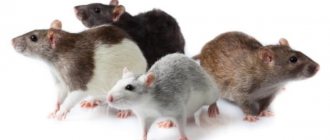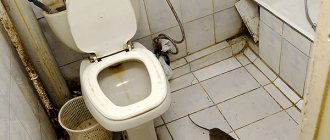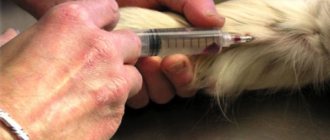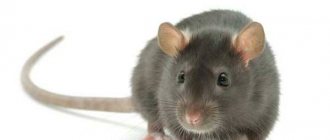Rats are very intelligent animals and can be taught to perform a wide variety of tricks and commands. Therefore, these rodents are easy to train to the tray. This will save a lot of time when it comes to cleaning the cage because it won't have to be done as often. This also saves additional money, since contaminated litter will also not need to be changed every day.
Training equipment
The first thing you will need is one or more trays. The number depends on the size of your cage and the places where rats like to go to the toilet.
However, you don't necessarily need to buy specially made trays from stores - old, clean cardboard boxes cut to size will do, although they will need to be replaced regularly. Plastic food containers will also work for this purpose.
You also need a suitable filler. This should be different from the substrate used on the cage floor and in digging boxes, as rats only need to associate it with the litter box.
Is this possible?
A rat jumping out of a toilet is not a horror story or a fairy tale, but a fairly common occurrence in everyday life. Rats are known to have excellent intelligence, so they are able to guess that a sewer pipe will help them get to a person and settle into his home.
In this way, a wild rat gets into the house most often from residents of the first and second floors , but there are cases when these smart rodents climbed even higher, to the fifth floor. But you ask: “How can rats move through the sewer and not suffocate in the water?” The answer is simple: rats, like all small rodents, can stay at depth for a long time, hold their breath and swim calmly. In apartment buildings, the sewer system is a network of pipes that connect the apartments. A rat can get into them through the basement, swim a little underwater, and then calmly climb up the vertical pipes.
Rats feel safe in the sewer, but in search of food and warmth they can leave it in any way.
Rat litter
Keep in mind that even the best litter needs to be changed regularly. It is recommended to change the litter in the tray once a day - yes, this is extra work, but your pet will thank you.
The best types of fillers:
- Paper pellet litter:
Paper pellets (such as Carefresh) are an ideal choice for rats as they absorb moisture and are fairly inexpensive. They quickly become soft when they get wet. Therefore, it is worth changing it quite often if you do not want your room to acquire an unpleasant odor.
- Straw pellet litter:
Straw litter works the same as paper litter. This type of litter is also good for rats because it is non-toxic and has excellent absorbent properties. - Shredded cardboard litter:
This type of bedding is good for rats because, like paper pellets and straw litter, cardboard has no harmful properties. - Cloth Bedding
: Some people choose to place cloth in the rat's litter box and clean it daily. This option is suitable if your rat is allergic to other types of litter. However, it is important that the fabric is in good condition. Such material can cause injury if it accidentally wraps around a rat's paws or tail.
However, the following types of fillers should definitely be avoided:
- Cedar and pine litter:
These types of litter should never be used for rat litter because they are extremely toxic. Both of these types of bedding smell great, but produce toxic fumes that can make your rats very sick.
- Cat Litter
: Cat litter, especially lumpy cat litter, can form clumps in a rat's stomach and make them very sick. Also, such bedding often generates copious dust, which is harmful to the respiratory system of rodents. Although, as a last resort, you can choose a natural, non-clumping cat litter. But this is still far from the best choice for a rat. - Cedar Litter:
Another type of litter that is virtually useless for almost any animal. Corn cob litter can cause problems if ingested and tends to become moldy.
Breeds of decorative rats
Let's take a look at the main varieties of pet rats to make it easier for you to choose. Decorative rats are divided into:
Division by body type
rats . The name was given because of its resemblance to Disney's baby elephant Dumbo, who could fly by waving his huge ears. Dumbo the rat's ears aren't that big, but they stand out. Rounded, sticking out more to the sides than to the top, like the others.
What are you watching? Quite an average size!
Standard . There’s nothing even to add to the name of the breed – a standard rat.
Standard? Sounds like an insult.
Tailless . An ordinary house rat, but without a tail.
Classification by coat type
Rex . Pets with beautiful curls.
Rex.
Satin (Satin, Longhair) . Thin, soft fur, which, when properly cared for, shimmers in the rays of light.
Satin Dumbo.
Sphinx (hairless) . Has a little “vegetation” on the head and back. An excellent choice for those who are allergic to wool.
Sphinx Dumbo. Well, aren't I adorable?
Downy (Fuzz) . They are distinguished by short and fine downy fur.
Down jacket.
Types of colors
Nowadays it is difficult to find a color that has not yet been developed by breeders. But there are also those that stand out from the general background.
Blue domestic rat. A very interesting shade of fur that needs to be seen in person (not every screen captures this color correctly).
Husky . The coloring is similar to that of dogs of the same breed.
Decorative white rat. People often look for a white rat with red eyes. The eyes are red because blood vessels are visible through them (in albino rats, not only the fur is discolored, but also the eye pigment).
Methods for training a rat to use a litter tray
You can train a rat to go to the toilet in a certain place by following the following algorithm:
Step 1:
Find a plastic or cardboard container that can serve as a rat litter tray. Pet stores and pet supply websites now sell trays designed for small rodents. Save money by using a shallow plastic food storage container or an old bowl that will serve the same purpose.
Step 2:
fill the new litter box with new litter, rat droppings and dirty litter. Rat droppings will help the rat understand that this is where it should go to the toilet.
Step 3:
Place the tray in the corner of the cage where the rat most often relieves himself. Most rats are very clean and prefer to only use one area to keep the rest of the cage clean and free of dirt. This makes it very easy to litter box train a rat as they are very tidy animals.
Step 4:
Clean the cage the same day the litter tray is installed in the rat cage. This will rid the space of all previous waste and help the rat understand that only the corner with the tray should be used for elimination.
Step 5:
Place your rat in a special litter tray so he knows it's there. This is especially important if the rat has a very large cage or a cage with several levels. The rat needs to be shown the location of the litter tray; quite possibly many times, especially if the rat does not immediately use the litter tray.
Step 6:
On the first day, check your rat every few hours to make sure it has used the litter box. If you find droppings outside the litter box, simply place the rat and its droppings in the litter box and say, “No!” If you notice your rat using the litter box, reward your pet with his favorite treat.
Vintage basket
Here we are dealing with a representative design in the style of modern rural fashion. Best suited for lovers of cycling or short distance travel on scooters. The basket itself is woven from flexible willow and equipped with an openwork wire lid, which prevents the cat from wanting to get out while moving. At the first glance at such a carrier, one is reminded of idyllic pictures from centuries ago, when food from the market was transported in a similar way on bicycles. The entire structure is conveniently attached to the steering wheel using leather straps and does not require much time for preparation.
The advantage of the option under consideration is, of course, its original design and originality. The downside is limited functionality. Although, if desired, the basket can be used for its intended purpose.
Price – 1,128 – 1,708 rubles.
What to do if a rat sleeps or eats in a tray
Don't worry, it happens. It is important to remember that rats do not have human concepts of rooms and hygiene. Yes, they are quite clean animals, they have toilet corners, and in the wild they clean their burrows of dirt. But pooping and peeing still have different meanings for them.
A rat may sleep in a litter tray just because it is convenient for him. Food is often eaten and stored in litter trays because they smell - they mark the territory and food as theirs. And yes, sometimes rats do eat their own waste. This is their way of recycling nutrients.
Experience
Sometimes appeals to the Criminal Code have no result. There can be many reasons for this, from the sluggishness of the management company’s employees to the lack of experienced specialists. Most often, deratization is carried out by SES workers upon request from the Criminal Code. If no action is taken. You can contact the SES directly without waiting for a reaction from the Housing Office. The sooner the procedure is performed, the more effective the result.
In addition, preventive measures are an important element of rodent control. Since it is not easy to remove rats from the sewer system, it is better to take care in advance to prevent them from entering the system. It is necessary to inspect pipelines and use protective nets made of durable metal. They cover ventilation shafts and other possible routes of entry into residential premises. Feeding areas (garbage dumps, garbage chutes) must be periodically treated with rat poison. This will help to avoid colonization and rapid reproduction of rats. Prevention must be carried out regularly; one-time measures are not enough.
Adviсe
- Separate the litter box in the cage as far away from the sleeping area as possible.
- Clean your rat's litter box at least once a week. Change the litter in the toilet once a week. Refill the litter box with fresh litter as soon as you place him back in the cage. Be sure to clean the bedding weekly to keep your cage odor-free.
- If there is even the slightest odor coming from the litter box, change the litter. Rats have a very sensitive respiratory system, and the smell of ammonia coming from the litter box can cause pneumonia in a rat.
- While you are training your rat, leave some dirty litter or droppings in the litter box so they know where it is.
- Reward your rat with a treat when he uses the litter box to reinforce good behavior. When you notice your rat going about his business in the litter box, praise him in a cheerful voice before giving him a small treat. During the first 2-3 weeks of training, give your rat a treat every time he enters this area of the cage.
- Clean up all droppings outside the litter box at all times. If you see droppings anywhere else in the cage, immediately pick them up and place them in the litter box. Make sure there is no rat waste anywhere, otherwise the training will not be as effective.
There are many benefits to toilet training. This makes the cage much cleaner, reduces odor and means you no longer have to clean the cage as often. If you allow your rat to play outside its cage for a bit, such as in a rat play area, it can also be trained to use the litter box outside the cage. Place the litter box in the same corner of the play area as the cage. If she needs a toilet break while playing, the rat can simply go to the litter box.
You might be interested
As soon as the Labrador puppy is 7-8 weeks old, the new owner can safely take him home. …read more
When an incredibly funny and cute Labrador puppy appears in a family, not everyone is fully …read more
The Russian Toy Terrier breed is very young: in our country the standard was formed in the 60s, and internationally ...read more
Raising and training Alabai (Central Asian Shepherd Dog) - advice from dog handlers
The Central Asian Shepherd is considered a “difficult” and rather specific breed. This is a freedom-loving herding dog, accustomed to ...read more
Jack Russell Terrier training - stages of raising a puppy
The Jack Russell Terrier is a very active dog. The breed belongs to the hunting family, so you need to be prepared for …read more











